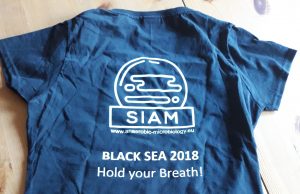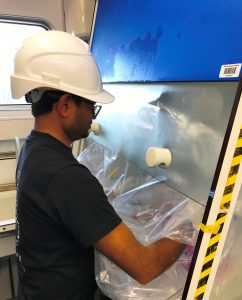64PE444 BLACK SEA CRUISE
Hold your breath!
Blog by Subhash Yadaf
“Let me first introduce myself! I am Subhash Yadav from India, working at Royal NIOZ. I have been already participated in different sampling tours in India and South Korea. So I was bit familiar with sampling tours. But in contrast to my previous experiences, the current expedition is really exciting! Especially the R/V PELAGIA which is well equipped with mobile laboratory where we can efficiently perform microbiological experiments like anaerobic inoculation, incubations and microscopic analysis. In addition, it is well equipped with instruments for in-situ observation like CARD-FISH. It also have very high quality sampling instruments and nice crew members. The weather is quite pleasant; beautiful sunny days, little wind but sea is almost calm. Seawater looks very clean and quite blue. In free times, I used to watch sea and several islands coming on our way. Its really good to watch and listen the voice of Sea on moving PELAGIA. Nice weather, friendly crew members and passionate researchers are just amazing! Our group is highly diverse which is focusing on different aspects of anaerobic microbiology. We belong to different countries which makes it very international. On the way to our Black sea expedition, I first landed to Heraklion, Greece on August, 13th where I had chance to see the CRETE city. It was really exciting to see the shopping complex and general store names written by Greek alphabets like alpha, beta, gamma, delta, psi, phi, epsilon etc. We left Heraklion on August, 14th for Black sea expedition.
We reached to Black sea on August 17th and started collecting water samples from different depths as much as possible. Black sea water colour is bit different from what we saw at Heraklion. It is greyish to somewhat blue in colour. I am on board PELAGIA to cultivate a candidate bacterial phyla (Cloacimonetes) which is quite abundant in deep water column (2000 m). Although, they are in good abundance in black sea but they behave as highly sophisticated creatures when we try to grow them in our lab. Genome analysis of this group of bacteria indicates that they might be involved in polysaccharide degradation and interestingly may have sulfate reducing activity too. For growing these group of bacteria, I have already prepared growth media made up of different carbon sources like cellobiose, lysine, histidine, proline, culture extracts etc. I am hoping they will like these nutrients and will be happy to propagate in our lab. I am also trying to provide them very homely environment in our lab where they can interact with their neighbours and share the nutrients for their growth. Finally, we have collected several litres of sea water from different depth (1000, 1500 and 2000m). I have also observed collected water samples under microscope where I am able to see different tiny living creatures which appears to be very happy. “BLACK” sea was named due to its inhospitable nature. But our microscopic observation indicates that black sea is very good (not “BLACK”) environment for creatures which do not “breathe on oxygen”.
Blog by Peter Fischer
“Hi everyone! This is the first blog for the NIOZ/SIAM Black Sea Cruise, or as we call it on the ship: 64PE444. We embarked three days ago on R/V Pelagia from the Heraklion seaport on Crete with one goal in mind: to research the wonderful world of the microbiology of the Black Sea. As I am writing this, we are waiting to cross the Bosporus strait, with a grand view of Istanbul to accompany us until the port authorities give us permission to pass. This does not mean we are idle! The ship is littered with pumps, filters, chemicals and bottles of all shapes and sizes that have to be ordered, placed inside our mobile laboratories and prepared for the many experiments we are planning to perform once we’ve reached the research station. So far, the trip has been wonderful, with great, sunny weather and calm seas which has given us plenty of opportunities to test out our equipment in the labs. The crew has been very helpful to get us scientists acquainted with the ship and the cook has been spoiling us with amazing food so we feel more than prepared to carry out our scientific tasks.

As a SIAM scientist, I am interested in the bacteria that thrive in the absence of oxygen in the sediment layer, 2000 meters below sea level. The stratified nature of this sediment makes the Black Sea a unique environment to look for novel metabolisms and identify the microbes capable of performing them. With the help of a piston core, an 18 meters long metal tube that will be plunged into the depths of the sea, I will collect sediment samples that will be sampled for DNA to see which organisms are able to live in this extreme environment. I will also use these sediment samples to enrich for bacteria capable of degrading specific compounds so we can study them in detail back home.
With 10 scientists from all disciplines on board, there’s a lot of science talk during our daily after-dinner discussions where everyone has to present their research. This way, we know why everyone’s on board and we can help them out immediately if their experiments needs an extra pair of hands or two. I’m very excited for the next few days of sampling and our way back to Limasol on Cyprus where we can start our experiments and find out what surprises the Black Sea has in store for us.”







